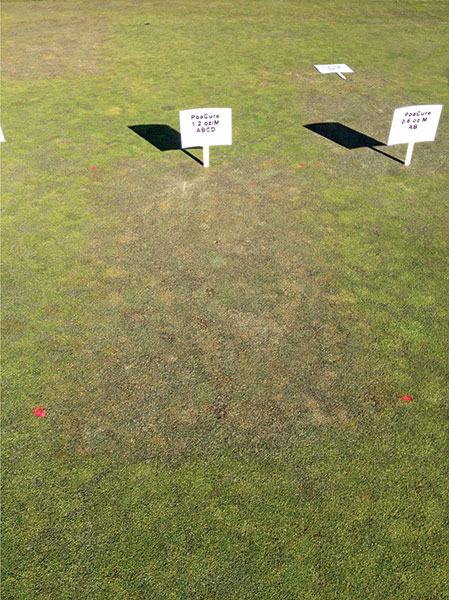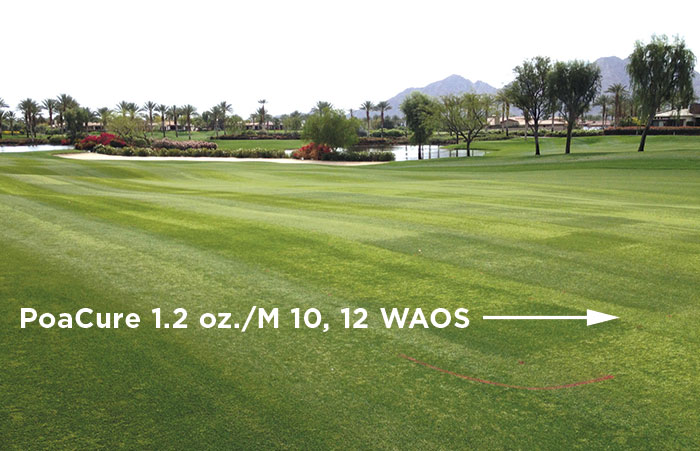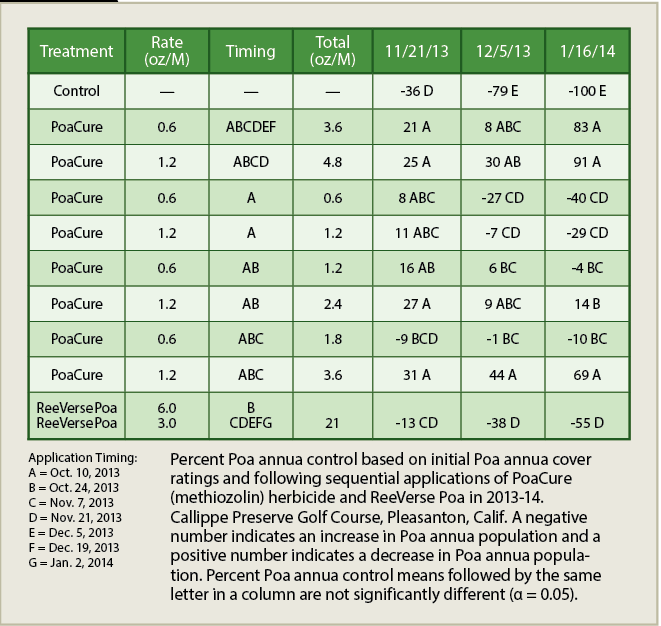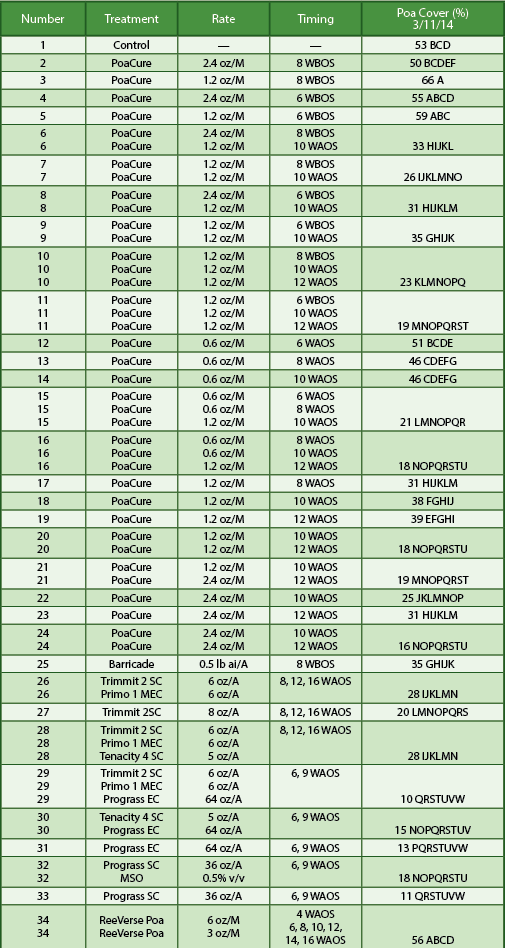Annual bluegrass control in California
 California’s Mediterranean climate is ideal for annual bluegrass (Poa annua). Under intensive management, however, this species is highly susceptible to several abiotic and biotic stresses, including heat/drought/cold, disease (e.g., anthracnose and rapid blight) and nematodes (e.g., Anguina in coastal northern California). Because of this, a growing number of golf courses are converting to creeping bentgrass (Agrostis stolonifera), which has better stress tolerance and putting traits (e.g., no seedheads under low mowing).
California’s Mediterranean climate is ideal for annual bluegrass (Poa annua). Under intensive management, however, this species is highly susceptible to several abiotic and biotic stresses, including heat/drought/cold, disease (e.g., anthracnose and rapid blight) and nematodes (e.g., Anguina in coastal northern California). Because of this, a growing number of golf courses are converting to creeping bentgrass (Agrostis stolonifera), which has better stress tolerance and putting traits (e.g., no seedheads under low mowing).
The challenge facing superintendents in California is keeping annual bluegrass from re-infesting new creeping bentgrass greens. There are no herbicides currently registered in the United States for selective annual bluegrass control in creeping bentgrass putting greens.

Figure 1 Poa annua control from PoaCure herbicide. Callippe Preserve Golf Course, Pleasanton, Calif. Photo taken Dec. 19, 2013.
Another scenario involving annual bluegrass eradication is on golf courses that overseed warm-season turf with cool-season grasses for winter color and playability. In California’s Coachella Valley around the Palm Springs area, ethofumesate (e.g., Prograss) has been the go-to herbicide for selective annual bluegrass control in bermudagrass turf overseeded with perennial ryegrass. Typically, two applications between Thanksgiving and Christmas provide effective Poa annua control throughout the winter golf season. However, an increasing number of courses have seen annual bluegrass resistance to repeated use of ethofumesate and other herbicide active ingredients.
One of my responsibilities as a cooperative Extension specialist and turfgrass researcher is to test products to help golf course superintendents and turf managers make informed agronomic and economic decisions. Whenever there’s a difficult challenge facing turf managers, whether it’s a formidable foe like Poa annua or severe drought and resultant water use restrictions, a surplus of products and remedies arise to save the day. But as the adage goes, “If it sounds too good to be true, it usually is.” Too many products sell based upon hearsay and testimonials rather than scientific research. This phenomenon forms the basis of future sales if by chance the product causes a positive response. However, without an untreated control, replication and elimination of other products in use at the time, how can we know with any certainty that product X resulted in Y response?
U.S. federal and state pesticide registration is an example of product testing at the other end of the spectrum from testimonials. Pesticides undergo extensive lab and field testing to establish efficacy and safety to organisms and the environment.
One product nearing completion of the U.S. federal registration process is PoaCure (methiozolin) herbicide from Moghu Research Center in South Korea. PoaCure is a novel product among Poa annua control herbicides, providing selective pre- and post-emergence control of annual bluegrass in creeping bentgrass putting greens and nearly all other turfgrass species and turf areas. The University of California, Riverside has conducted extensive testing of PoaCure on golf courses throughout California and the western U.S. since 2010. It was tested in 2013 and 2014 alongside ReeVerse Poa, a product from ReeCourse Golf, LLC. According to ReeCourse Golf, this product contains SumaGrow, a microbial blend selected for its ability to improve the health of the soil, reduce fertilizer inputs and improve water efficiency. Another description claims: “ReeVerse Poa works to impair the immune system of the Poa so that it gradually dies off and the healthy grass grows in around it. The ReeVerse Poa does this without leaving brown spots!” More information is available at
earthcarewithsumagrow.com/test-results/golf-courses.

Figure 2 Effects of products on Poa annua control in bermudagrass turf overseeded with perennial ryegrass. Note Po\aCure plot designated by the arrow. Toscana Country Club, Indian Wells, Calif. Photo taken March 11, 2014.
Results
Data from the two experiments presented in this article are representative of results from multiple experiments. For clarity, I’m presenting only a single year’s data for each experiment.
Poa annua control in putting greens
A study was conducted from October 2013 to January 2014 on a 9-year-old practice green at Callippe Preserve Golf Course in Pleasanton, Calif., a suburb of the San Francisco Bay area. The composition of the green was about 50/50 Dominant Plus creeping bentgrass and Poa annua. Soil was a 90/10 sand/peat mix conforming to USGA recommendations. Mowing height was 0.125 inches. A CO2-powered backpack sprayer was calibrated to deliver an output of 2 gal/1,000 sq. ft. All chemical treatments received 5 minutes of irrigation following application, and standard irrigation practices thereafter. Plot size was 4 ft. x 6 ft., with four replications of each treatment. Percent Poa annua control was calculated based on Poa annua cover (0 to 100 percent) determined at the start of the experiment and every two weeks thereafter.
Chemical treatment effect was significant on three rating dates (Table 1). In general, higher rates — and more important, higher total amounts of PoaCure — resulted in the best Poa annua control. These results corroborated other findings that at least 4.8 oz/M of PoaCure applied over a period of 10 to 16 weeks is required for optimum Poa annua control on putting greens in California. ReeVerse Poa was not effective in reducing Poa annua populations. In fact, Poa annua increased rather than decreased following applications of this product.
Control in overseeded turf
A study was conducted from August 2013 to March 2014 at Toscana Country Club in Indian Wells, Calif. The bermudagrass fairway was overseeded with perennial ryegrass on Oct. 15. A CO2-powered backpack sprayer was calibrated to deliver an output of 2 gal/1,000 sq. ft. Chemical treatments were applied from eight weeks before to 16 weeks after overseeding to evaluate Poa annua control (Table 2). Plot size was 4 ft. x 6 ft., with four replications of each treatment. Poa annua cover (0 to 100 percent), perennial ryegrass thinning and turf stand quality were evaluated throughout the study.
ReeVerse Poa did not reduce Poa annua populations (Table 2) or improve stand quality (data not shown) in comparison to the untreated control. Overall, we saw no reduction in Poa annua or improvement of turf quality from ReeVerse Poa in this and the putting green trial. Results of this study suggested that PoaCure has greater post-emergence than pre-emergence activity on Poa annua. Although a total of 2.4 to 4.8 oz./1,000 sq. ft. of product applied eight to 12 weeks after overseeding provided among the best Poa annua control, PoaCure caused objectionable thinning to the young stand of perennial ryegrass. Results of this and subsequent research suggests that superintendents should delay PoaCure applications until at least 12 weeks after overseeding perennial ryegrass. In the Coachella Valley, this may be too late to eradicate annual bluegrass before it forms objectionable seedheads.
Barricade (prodiamine) herbicide applied eight weeks before overseeding also caused perennial ryegrass stand thinning, however, the effect was observed at the time of emergence (data not shown). In time, enough perennial ryegrass seedlings survived to form an acceptable stand of cool-season turf. Unlike other golf courses in the area, Prograss (ethofumesate) herbicide continued to be active on Poa annua at Toscana Country Club, and no differences were found between the emulsifiable and soluble concentrate formulations, although they were applied at different rates.
If Prograss is losing activity against Poa annua, these results suggested that tank mixing with Trimmit (paclobutrazol) and Primo (trinexapac-ethyl) plant growth regulators could help boost Poa annua control. Use of PGRs beyond Christmas caused considerable turf growth regulation effects because of cold temperatures, which later subsided with warmer weather (data not shown). Tank mixing Tenacity (mesotrione) herbicide with Prograss resulted in turf bleaching for one to two weeks after each application (data not shown).
Jim Baird, Ph.D., is a turfgrass specialist at the University of California, Riverside. You may reach him at jbaird@ucr.edu for more information.
Acknowledgments
Thanks to the United States Golf Association, Moghu Research Center and the California Turfgrass and Landscape Foundation for supporting this research.
Photos by: Jim Baird
Are you patient enough for PoaCure?
As PoaCure registration approaches in the United States, Jim Baird, Ph.D., provides some useful tips and facts about this game-changing herbicide.
- Like Heinz Ketchup, PoaCure is “slow good.” Especially on greens, the herbicide is applied sequentially over an extended period, usually three to six applications every two weeks. Label recommendations are based on providing the ideal scenario for this product; seamless transition from Poa annua-creeping bentgrass to creeping bentgrass (or other desired) turf.
- Increasing the rate, shortening the application interval or applying close to wet and/or freezing weather can accelerate PoaCure activity. In most cases, doing so results in sudden loss of Poa annua (you always have more than you think), injury or loss of creeping bentgrass/desired turf or both. This not what your ownership or golfers desire.
- When applied according to label recommendations, PoaCure is safe on creeping bentgrass and most turfgrass species maintained at putting green or at higher heights of cut. The herbicide severely injures Colonial and velvet bentgrasses. That said, certain creeping bentgrass cultivars like L-93 and Providence, which are no longer in production, appear to be more sensitive to PoaCure, as are various segregates of other cultivars. On the other hand, we know that Pure Distinction, Tyee and likely several other creeping bentgrass cultivars are extremely tolerant to PoaCure at exaggerated application rates. This is not surprising given that there also is a range of tolerance to PoaCure among annual bluegrass biotypes. I advise the patient approach when dealing with tolerant Poa annua biotypes. For example, you may wish to use spot applications with a dauber or a repeat sequence of applications according to label recommendations.
- PoaCure is a root-active herbicide, so irrigation following application is essential to achieve desired results. This is especially important for higher-cut turf to help deliver the herbicide through the canopy and organic matter into the underlying root zone. On the other hand, heavy precipitation following applications speeds up activity, often beyond desired expectations. It also may cause injury or loss of desired turf.
- PoaCure has both pre- and post-emergence activity, so allow at least two to six weeks after final sequential application before seeding, depending on use rate. Once again, proper use of this herbicide will provide seamless transition without the need for interseeding to fill in voids left by Poa annua eradication. In the case of overseeding bermudagrass turf with perennial ryegrass, our research found that initial application of PoaCure should be delayed at least 12 weeks after seeding.
- Have patience with PoaCure!!!











